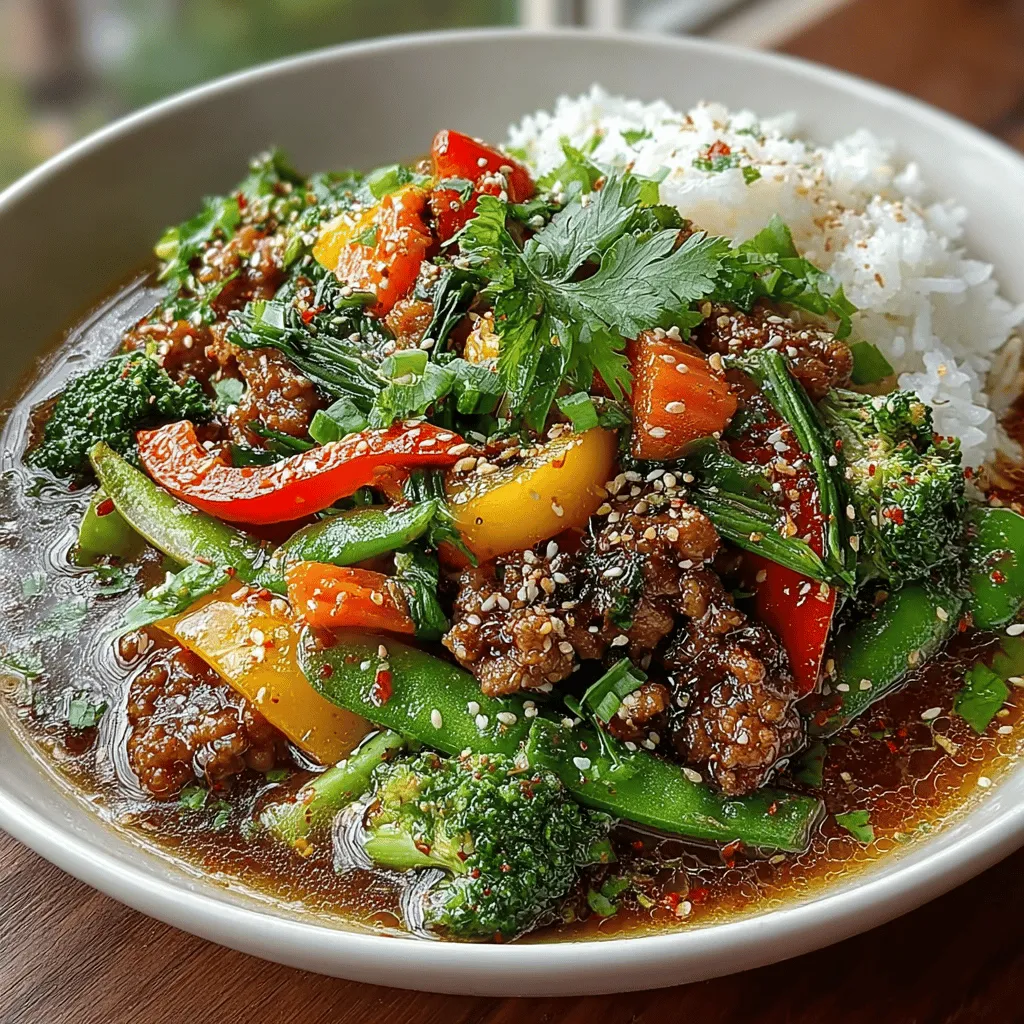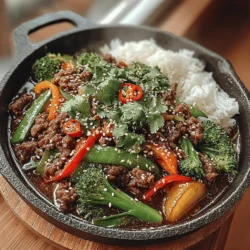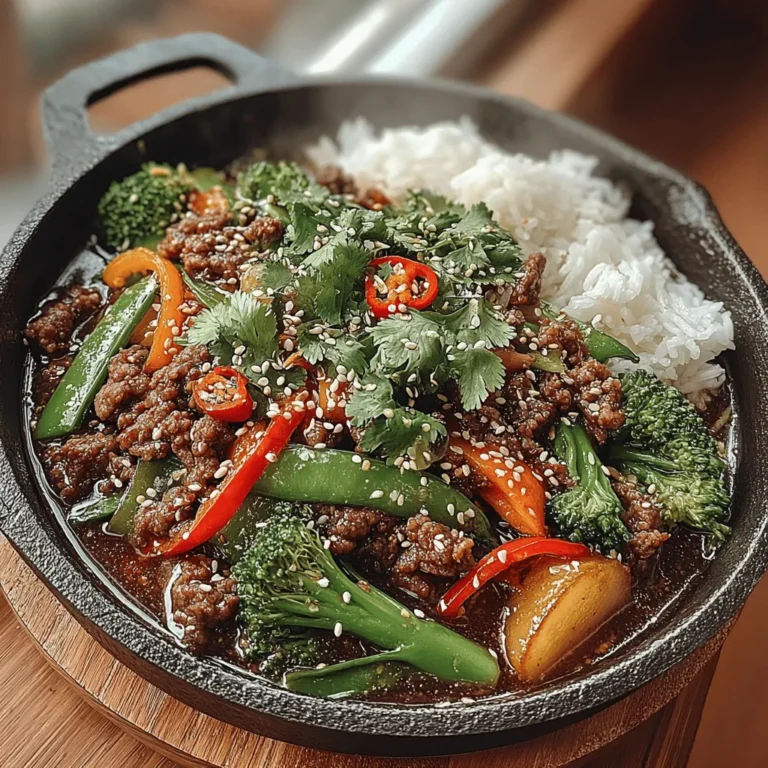Stir-fries are a fantastic way to create a quick, nutritious meal that is both satisfying and flavorful. This Savory Turkey and Vegetable Stir-Fry is an ideal dish for busy weeknights when time is limited but health is a priority. Utilizing ground turkey and a colorful assortment of fresh vegetables, this recipe not only delivers on taste but also provides a wealth of health benefits. Ground turkey is a lean protein that supports muscle growth and weight management, while the array of vegetables ensures a rich intake of vitamins and minerals. Plus, this stir-fry can easily be prepared in advance, making it a perfect option for meal prepping.
Ingredients
– 1 lb ground turkey
– 2 tablespoons vegetable oil
– 2 cups mixed vegetables (bell peppers, broccoli, carrots, and snap peas)
– 2 cloves garlic, minced
– 1 tablespoon fresh ginger, minced
– 3 tablespoons soy sauce
– 2 tablespoons oyster sauce (optional)
– 1 tablespoon sesame oil
– Salt and pepper to taste
– Cooked rice or noodles for serving
Instructions
1. Heat the vegetable oil in a large skillet or wok over medium-high heat.
2. Add the ground turkey to the skillet and cook until browned, breaking it apart with a spatula, about 5-7 minutes.
3. Once the turkey is cooked through, push it to one side of the skillet.
4. Add the minced garlic and ginger to the empty side of the skillet and sauté for about 30 seconds until fragrant.
5. Stir in the mixed vegetables and cook for an additional 3-5 minutes until they are tender-crisp.
6. Pour the soy sauce and oyster sauce (if using) over the turkey and vegetables, mixing well to combine.
7. Drizzle the sesame oil over the stir-fry, season with salt and pepper to taste, and give it a final stir.
8. Serve hot over cooked rice or noodles.
Understanding the Ingredients
Ground Turkey
Ground turkey is a versatile protein option that is low in fat and high in protein, making it an excellent choice for those looking to maintain a healthy diet. It is also rich in essential nutrients such as B vitamins and selenium, which play important roles in energy production and immune function. Using ground turkey in this stir-fry not only adds a delicious flavor but also helps to keep the dish light and nutritious.
The Importance of Fresh Vegetables
Incorporating a variety of fresh vegetables into your meals is crucial for overall health. Vegetables are packed with vitamins, minerals, and antioxidants that contribute to a balanced diet. In this stir-fry, the mix of bell peppers, broccoli, carrots, and snap peas not only enhances the visual appeal of the dish but also provides a range of nutrients that support bodily functions. Fresh vegetables also add texture and flavor, making each bite more enjoyable.
A Closer Look at Sauces
Soy Sauce
Soy sauce is a staple in many Asian cuisines and serves as a key flavoring agent in this stir-fry. It adds a savory umami taste that complements the turkey and vegetables beautifully. However, it is important to be mindful of the sodium content in soy sauce, as it can be high. Opting for low-sodium soy sauce can be a healthier alternative.
Oyster Sauce
Oyster sauce is an optional ingredient that can elevate the flavor profile of your stir-fry. Known for its rich, umami taste, it adds depth to the overall dish. If you have dietary restrictions or prefer a vegetarian option, it’s possible to omit this ingredient without compromising the dish’s integrity.
Sesame Oil
Adding sesame oil at the end of the cooking process introduces a unique aroma and flavor to the stir-fry. It has a distinct nutty taste that enhances the overall dish, making it more complex and satisfying. A little goes a long way, so be sure to use it judiciously for the best results.
Preparation Steps for the Perfect Stir-Fry
Heating the Oil
Starting with the right temperature is crucial for a successful stir-fry. Heating the oil until it shimmers ensures that the turkey cooks evenly and gives it a nice sear. This step is fundamental in achieving that coveted stir-fry texture.
Cooking the Turkey
To achieve the perfect texture, be sure to break the turkey apart as it cooks. This not only helps it brown evenly but also prevents clumping, making for a more enjoyable eating experience.
Sautéing Garlic and Ginger
Garlic and ginger are aromatic powerhouses that can significantly enhance the flavor of your stir-fry. Sautéing them briefly before adding the vegetables allows their essential oils to infuse the oil, creating a fragrant base for your dish.

Adding Vegetables: Tips for Stir-Frying to Retain Crispness
When preparing your savory turkey and vegetable stir-fry, the way you handle your vegetables can significantly affect their texture and flavor. To ensure your vegetables remain crisp, consider these tips:
– Cut Uniformly: Slice your vegetables into uniform pieces to ensure even cooking. Thicker slices may require longer cooking times, while thinner slices can become mushy quickly.
– High Heat: Always use high heat to quickly sear the vegetables. This technique helps to lock in flavors while preventing them from becoming soggy.
– Avoid Overcrowding: Stir-frying in batches rather than overcrowding the pan allows for better heat distribution, ensuring that each piece cooks properly without steaming.
– Add in Stages: Start with denser vegetables like carrots and bell peppers, then add quicker-cooking items like snap peas or broccoli later in the process to maintain their crunch.
Incorporating Sauces: Balancing Flavors and Optimizing Taste
The sauce is a crucial element in any stir-fry, providing moisture and flavor. Here are some tips for achieving a well-balanced sauce:
– Start Simple: Begin with a base of soy sauce, garlic, and ginger, then build on it with additional ingredients like oyster sauce or sesame oil for complexity.
– Taste as You Go: Always taste your sauce before adding it to the stir-fry. Adjust the flavors by adding more acidity (like vinegar or lime juice) or sweetness (like honey or sugar) as needed.
– Layer Flavors: Add sauces gradually and allow them to reduce slightly in the pan, which intensifies the flavors and achieves a richer taste.
Thickening the Sauce: Importance of Cornstarch and Achieving the Right Consistency
A great stir-fry sauce should have a glossy, thick consistency that clings to the ingredients. Here’s how to achieve this:
– Cornstarch Slurry: Mix cornstarch with a small amount of cold water to create a slurry. This prevents clumping when added to the hot stir-fry.
– Cook for Thickness: Once you add the cornstarch slurry, give it a minute or two to cook through. This will help it thicken and become glossy.
– Adjusting Consistency: If the sauce is too thick, add a splash of broth or water to loosen it. Conversely, if it’s too thin, add a bit more cornstarch slurry.
Final Touches: The Role of Garnishes in Enhancing Presentation and Flavor
Garnishes can elevate your dish both visually and flavor-wise. Here are some suggestions:
– Fresh Herbs: Sprinkle chopped green onions or cilantro on top for a burst of color and freshness.
– Sesame Seeds: Toasted sesame seeds add a nutty flavor and an appealing crunch.
– Chili Flakes: For those who enjoy a bit of heat, a pinch of chili flakes can enhance the overall flavor profile.
Serving Suggestions
Ideal Pairings: Cooked Jasmine Rice vs. Quinoa
Pair your savory turkey and vegetable stir-fry with either jasmine rice or quinoa. Jasmine rice offers a fragrant, slightly sticky base that absorbs the sauce well, while quinoa adds a nutty flavor and extra protein, making it a nutritious alternative.
Portion Sizes and Presentation Tips for a Visually Appealing Dish
Aim for a balanced portion size, typically around one cup of stir-fry per serving. For an attractive presentation, serve the stir-fry in a shallow bowl, creating a mound of rice or quinoa and artfully arranging the stir-fry on top. A sprinkle of fresh herbs can add color.
Variations for Dietary Preferences: Making it Vegetarian or Gluten-Free
To cater to different dietary needs, consider these variations:
– Vegetarian: Substitute turkey with tofu or tempeh, and incorporate more vegetables like mushrooms and bell peppers for added flavor and texture.
– Gluten-Free: Use tamari instead of soy sauce to maintain the dish’s gluten-free integrity while still providing a savory flavor.
Nutritional Insights
Breakdown of Calories and Nutritional Content per Serving
A typical serving of savory turkey and vegetable stir-fry contains approximately 300-400 calories, depending on the amount of oil and sauce used. The turkey provides lean protein, while the vegetables contribute essential vitamins and minerals.
Discussing the Balance of Macronutrients in the Dish
This stir-fry is a well-balanced meal, offering protein from turkey, healthy fats from sesame oil, and carbohydrates from your choice of rice or quinoa. The inclusion of various vegetables also ensures a good intake of fiber.
Benefits of Incorporating This Stir-Fry into a Balanced Diet
Incorporating this stir-fry into your regular meal rotation can contribute to a balanced diet. It is rich in nutrients, quick to prepare, and can be easily adjusted to fit personal preferences or dietary restrictions.
Conclusion
In summary, the savory turkey and vegetable stir-fry is not only simple to prepare but also packed with health benefits. Its versatility allows for endless adaptations, making it an excellent option for a quick, nutritious meal at home. Whether you stick to the original recipe or customize it to suit your tastes, this dish is sure to become a staple in your cooking repertoire. Embrace the stir-fry concept in your everyday meals, and enjoy the balance of flavors and nutrients it offers.

